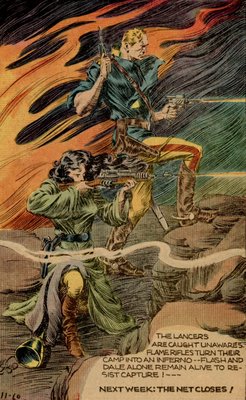
This jewel of a drawing by the great Robert Fawcett was a spot illustration for the story Mutiny in Paradise which appeared in This Week magazine in May 1957.
The original magazine was printed on cheap pulp paper, and most copies have long since crumbled into silt. I am posting a scan of the original so that this fine, arrogant drawing will continue to get the audience it deserves. Contrast Fawcett's use of drybush to convey the depth of the jungle outside the hut with the slashing brush strokes of the wall which energize the whole drawing.

Fawcett understood anatomy so well that he was able to depict the feet of the character with speed and confidence, despite their odd angle.

Most important, note how the subject matter was subordinated to the abstract design of the picture. Fawcett always said that the longer an artist could work on a representational drawing at the purely abstract level, the better.

























